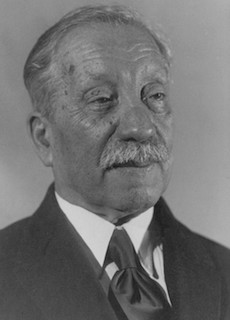Boris Galerkin facts for kids
Quick facts for kids
Boris Galerkin
|
|
|---|---|
| Бори́с Григо́рьевич Галёркин | |
 |
|
| Born |
Boris Grigoryevich Galerkin
4 March 1871 Polotsk, Vitebsk Governorate, Russian Empire
|
| Died | 12 July 1945 (aged 74) |
| Alma mater | Saint Petersburg State Institute of Technology |
| Known for | Galerkin method |
| Spouse(s) | Revekka Treivas |
| Scientific career | |
| Fields |
|
| Institutions | Military Engineering-Technical University |
Boris Grigoryevich Galerkin was a brilliant Soviet mathematician and engineer. He is famous for creating a special method to solve complex math problems. This method is especially useful in building and design.
Contents
Biography
Early Life
Boris Galerkin was born on March 4, 1871, in Polotsk, which is now part of Belarus. His family owned a house, but they didn't earn much money. So, at age 12, Boris began working as a calligrapher in a court.
He finished school in Polotsk. To continue his education, he needed to pass extra exams. He took these exams in Minsk in 1893. That same year, he joined the mechanics department at the St. Petersburg Technological Institute.
Since he didn't have much money, Boris worked as a draftsman. He also gave private lessons to support himself. He married Revekka Treivas, but they did not have children.
Academic Journey
Galerkin's first scientific paper was published by his institute. It was about how structures bend and move. He wrote this important work during a challenging period in his life.
In 1909, Boris traveled to Europe to study different buildings and constructions. Over the next four years, he visited Germany, Austria, Switzerland, Belgium, and Sweden. These trips helped him grow his scientific interests.
Galerkin taught students about structural mechanics. This field deals with how buildings and bridges stand strong. He worked with famous scientists like V.L.Kirpichov. Many of his colleagues also taught at the Polytechnical Institute.
In 1913, Galerkin helped design a special metal frame for a power plant in St. Petersburg. This was one of the first buildings in Russia to use a strong metal frame for heavy loads. It became known as a unique engineering project in Europe.
The Galerkin Method
In 1915, Galerkin shared a new idea in an article. He proposed a way to find approximate solutions for differential equations. These equations describe how things change. His method was very useful for analyzing structures like beams and plates.
Another scientist, I.G. Bubnov, had a similar idea earlier. But Galerkin's method was special. He saw it as a general way to solve many types of differential equations. This idea became very important, not just for building design but for many areas of mathematical physics.
Today, the Galerkin method is known worldwide. It's used as a base for computer algorithms in many fields. These include mechanics, thermodynamics, electromagnetism, and hydrodynamics.
Leadership and Recognition
In 1919, Galerkin became a professor at the 2nd Polytechnical Institute. He continued teaching structural mechanics. In 1920, he won a competition for a professor chair in structural mechanics.
He later moved to the civil engineering faculty. This area was a better fit for his scientific and engineering work. From 1917 to 1919, he published many works on how rectangular and triangular plates bend.
In 1923, Galerkin was chosen as the dean of the civil engineering faculty. This was a difficult time for the institute. He showed great leadership skills. He managed to keep the faculty focused on education.
From 1924 to 1929, he also taught at the Railway Engineers Institute and St. Petersburg University. In 1924, he made his last trip abroad to a mechanics conference in the Netherlands.
Galerkin helped save the road-making section at his faculty from closing. He also got approval to build large laboratories. These later became the Hydrotechnical Research Institute.
In 1928, Galerkin became a corresponding member of the USSR Academy of sciences. This was a big honor. By the 1920s, he was a world-famous scientist. Engineers often asked him for advice on big projects. These included power plants and paper mills.
In 1934, he received two doctoral degrees. He was also given the title of Honoured Worker in Science and Engineering. In 1936, he became a full member of the USSR Academy of Sciences. He held many important positions. He was even asked to check the design of the Palace of Soviets in Moscow.
Despite all his titles, Galerkin remained a professor. He taught advanced courses on the theory of elasticity. Students would come to his lectures just to see a "real academician." He was a humble man, short and with a quiet voice.
War Times and Passing
In 1939, Galerkin became the head of the structural mechanics department at the Military Engineering-Technical University. He was given the rank of lieutenant general. Even though he had never been in the army, he wore the general's uniform. He was quite shy about it.
When World War II began in 1941, Galerkin joined a commission to build defenses for the city. He became the supervisor of this important work. He also led a group of experts for the city's engineering defense.
Later, he moved to Moscow. There, he joined the military engineering commission of the Academy of Sciences. The hard, non-stop work affected his health. Boris Galerkin passed away in Moscow on July 12, 1945. This was shortly after the end of the war. He is buried in the Volkovo Cemetery in St. Petersburg.
Mathematical Contributions
Boris Galerkin's name is closely linked to the finite element method. This is a powerful way to solve complex math problems using computers. It helps engineers and scientists understand how things behave.
The "Galerkin methods" include:
- The Galerkin method: A way to find approximate solutions to problems. It's very important in the finite element method.
- The Petrov–Galerkin method
- The streamline upwind Petrov–Galerkin method (SUPG)
- The Discontinuous Galerkin method

